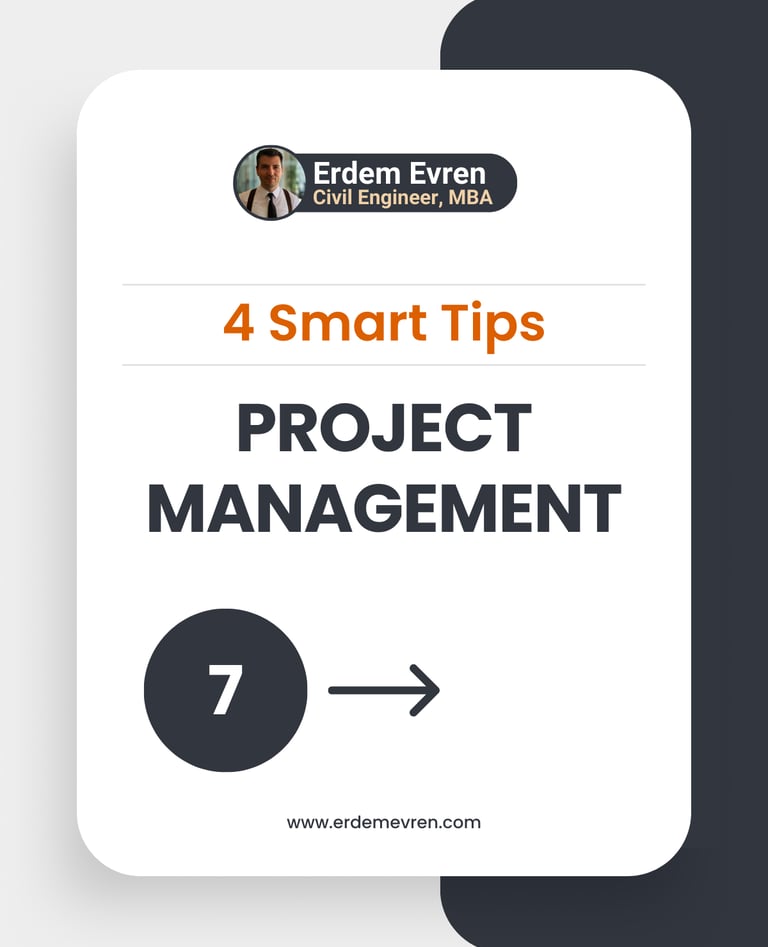Expert Project Management Tips for Better Results 📈
Concise yet insightful!


𝟰 𝗦𝗺𝗮𝗿𝘁 𝗣𝗿𝗼𝗷𝗲𝗰𝘁 𝗠𝗮𝗻𝗮𝗴𝗲𝗺𝗲𝗻𝘁 𝗧𝗶𝗽𝘀 𝗳𝗼𝗿 𝗕𝗲𝘁𝘁𝗲𝗿 𝗥𝗲𝘀𝘂𝗹𝘁𝘀 (𝘄𝗶𝘁𝗵 𝗗𝗲𝘁𝗮𝗶𝗹𝗲𝗱 𝗦𝘁𝗲𝗽𝘀 𝗼𝗻 𝗛𝗼𝘄 𝘁𝗼 𝗜𝗺𝗽𝗹𝗲𝗺𝗲𝗻𝘁 𝗧𝗵𝗲𝗺)
Effective project management is about more than just completing tasks—it’s about strategic execution that drives long-term success. Here are four key project management tips, along with steps you can take to put them into action:
🔑 𝗜𝗱𝗲𝗻𝘁𝗶𝗳𝘆 𝗞𝗲𝘆 𝗥𝗲𝘀𝗼𝘂𝗿𝗰𝗲𝘀
◉ What it means: Ensuring you have the right people, tools, and materials to achieve project success is critical for smooth execution.
◉How to do it: Start by creating a detailed resource plan. List every human, material, and equipment resource you need for the project. Use project management tools like Microsoft Project or Asana to track availability and allocate resources efficiently. Continuously review and update your resource pool as the project progresses to avoid delays.
🎯 𝗕𝗮𝗹𝗮𝗻𝗰𝗲 𝗦𝗵𝗼𝗿𝘁-𝘁𝗲𝗿𝗺 𝗮𝗻𝗱 𝗟𝗼𝗻𝗴-𝘁𝗲𝗿𝗺 𝗚𝗼𝗮𝗹𝘀
◉What it means: It’s important to meet immediate project goals while also keeping the long-term vision in mind for sustainable success.
◉How to do it: Break your project into short-term milestones that contribute to larger strategic objectives. Set clear KPIs for each phase and review your progress regularly. Visualize this with a project roadmap using tools like Trello or Jira, which helps you monitor how current tasks support the long-term vision and make adjustments when necessary.
📊 𝗖𝗼𝗻𝗱𝘂𝗰𝘁 𝗮 𝗠𝗶𝗱-𝗽𝗿𝗼𝗷𝗲𝗰𝘁 𝗥𝗲𝘃𝗶𝗲𝘄
◉What it means: Regularly assessing progress ensures that your project stays aligned with its goals and allows you to make necessary adjustments.
◉How to do it: Plan a formal review midway through the project to evaluate whether you’re on track to meet objectives. Use data-driven insights from project management tools like Monday.com or Wrike to compare progress against initial timelines and goals. During this review, gather feedback from stakeholders and make adjustments to the timeline, resource allocation, or scope if needed.
🤖 𝗨𝘀𝗲 𝗔𝘂𝘁𝗼𝗺𝗮𝘁𝗶𝗼𝗻 𝗳𝗼𝗿 𝗧𝗮𝘀𝗸 𝗔𝘀𝘀𝗶𝗴𝗻𝗺𝗲𝗻𝘁
◉What it means: Automating repetitive tasks not only saves time but also reduces administrative workload, allowing your team to focus on critical project activities.
◉How to do it: Implement automation tools like Zapier, ClickUp, or Slack to automatically assign tasks to team members based on predefined triggers or workflows. For example, when a task reaches a specific status, automation can assign it to the appropriate person, reducing manual oversight and boosting efficiency. Use project templates to standardize routine task assignments.
